Mubbasir Kapadia
StyleMotif: Multi-Modal Motion Stylization using Style-Content Cross Fusion
Mar 27, 2025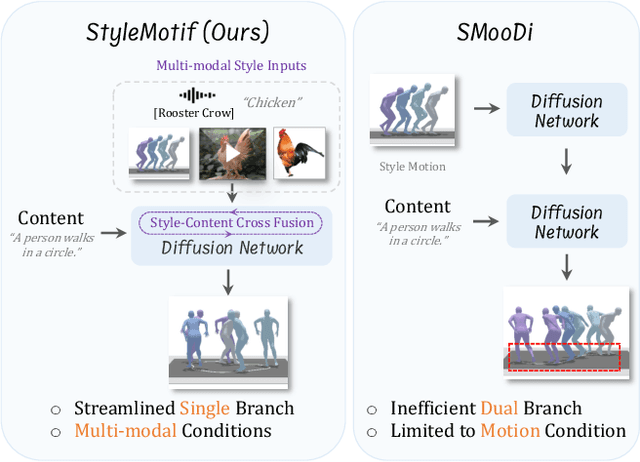
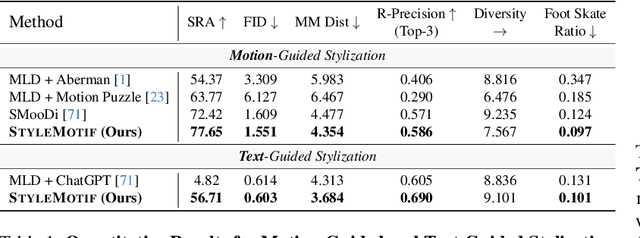
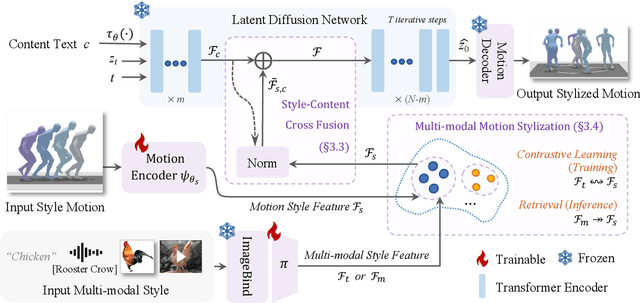
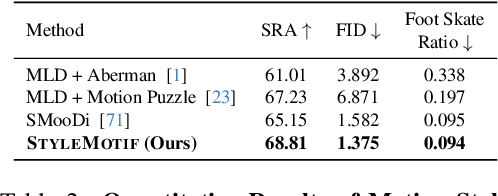
Abstract:We present StyleMotif, a novel Stylized Motion Latent Diffusion model, generating motion conditioned on both content and style from multiple modalities. Unlike existing approaches that either focus on generating diverse motion content or transferring style from sequences, StyleMotif seamlessly synthesizes motion across a wide range of content while incorporating stylistic cues from multi-modal inputs, including motion, text, image, video, and audio. To achieve this, we introduce a style-content cross fusion mechanism and align a style encoder with a pre-trained multi-modal model, ensuring that the generated motion accurately captures the reference style while preserving realism. Extensive experiments demonstrate that our framework surpasses existing methods in stylized motion generation and exhibits emergent capabilities for multi-modal motion stylization, enabling more nuanced motion synthesis. Source code and pre-trained models will be released upon acceptance. Project Page: https://stylemotif.github.io
ArchSeek: Retrieving Architectural Case Studies Using Vision-Language Models
Mar 24, 2025Abstract:Efficiently searching for relevant case studies is critical in architectural design, as designers rely on precedent examples to guide or inspire their ongoing projects. However, traditional text-based search tools struggle to capture the inherently visual and complex nature of architectural knowledge, often leading to time-consuming and imprecise exploration. This paper introduces ArchSeek, an innovative case study search system with recommendation capability, tailored for architecture design professionals. Powered by the visual understanding capabilities from vision-language models and cross-modal embeddings, it enables text and image queries with fine-grained control, and interaction-based design case recommendations. It offers architects a more efficient, personalized way to discover design inspirations, with potential applications across other visually driven design fields. The source code is available at https://github.com/danruili/ArchSeek.
Less is More: Improving Motion Diffusion Models with Sparse Keyframes
Mar 18, 2025Abstract:Recent advances in motion diffusion models have led to remarkable progress in diverse motion generation tasks, including text-to-motion synthesis. However, existing approaches represent motions as dense frame sequences, requiring the model to process redundant or less informative frames. The processing of dense animation frames imposes significant training complexity, especially when learning intricate distributions of large motion datasets even with modern neural architectures. This severely limits the performance of generative motion models for downstream tasks. Inspired by professional animators who mainly focus on sparse keyframes, we propose a novel diffusion framework explicitly designed around sparse and geometrically meaningful keyframes. Our method reduces computation by masking non-keyframes and efficiently interpolating missing frames. We dynamically refine the keyframe mask during inference to prioritize informative frames in later diffusion steps. Extensive experiments show that our approach consistently outperforms state-of-the-art methods in text alignment and motion realism, while also effectively maintaining high performance at significantly fewer diffusion steps. We further validate the robustness of our framework by using it as a generative prior and adapting it to different downstream tasks. Source code and pre-trained models will be released upon acceptance.
Cardiverse: Harnessing LLMs for Novel Card Game Prototyping
Feb 10, 2025Abstract:The prototyping of computer games, particularly card games, requires extensive human effort in creative ideation and gameplay evaluation. Recent advances in Large Language Models (LLMs) offer opportunities to automate and streamline these processes. However, it remains challenging for LLMs to design novel game mechanics beyond existing databases, generate consistent gameplay environments, and develop scalable gameplay AI for large-scale evaluations. This paper addresses these challenges by introducing a comprehensive automated card game prototyping framework. The approach highlights a graph-based indexing method for generating novel game designs, an LLM-driven system for consistent game code generation validated by gameplay records, and a gameplay AI constructing method that uses an ensemble of LLM-generated action-value functions optimized through self-play. These contributions aim to accelerate card game prototyping, reduce human labor, and lower barriers to entry for game developers.
CASIM: Composite Aware Semantic Injection for Text to Motion Generation
Feb 04, 2025Abstract:Recent advances in generative modeling and tokenization have driven significant progress in text-to-motion generation, leading to enhanced quality and realism in generated motions. However, effectively leveraging textual information for conditional motion generation remains an open challenge. We observe that current approaches, primarily relying on fixed-length text embeddings (e.g., CLIP) for global semantic injection, struggle to capture the composite nature of human motion, resulting in suboptimal motion quality and controllability. To address this limitation, we propose the Composite Aware Semantic Injection Mechanism (CASIM), comprising a composite-aware semantic encoder and a text-motion aligner that learns the dynamic correspondence between text and motion tokens. Notably, CASIM is model and representation-agnostic, readily integrating with both autoregressive and diffusion-based methods. Experiments on HumanML3D and KIT benchmarks demonstrate that CASIM consistently improves motion quality, text-motion alignment, and retrieval scores across state-of-the-art methods. Qualitative analyses further highlight the superiority of our composite-aware approach over fixed-length semantic injection, enabling precise motion control from text prompts and stronger generalization to unseen text inputs.
TrajDiffuse: A Conditional Diffusion Model for Environment-Aware Trajectory Prediction
Oct 14, 2024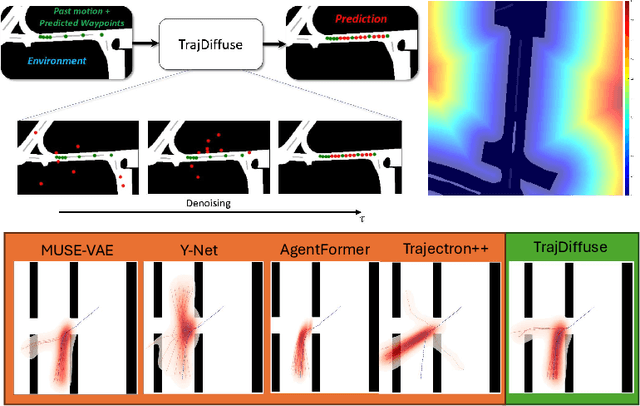
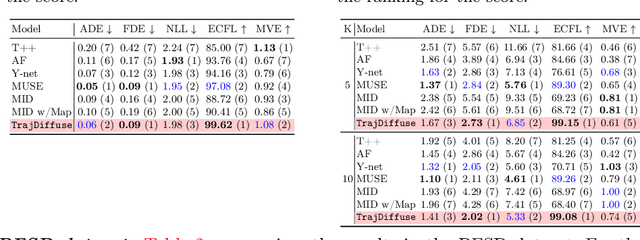
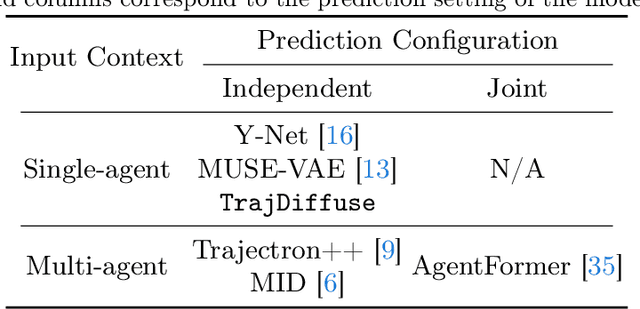
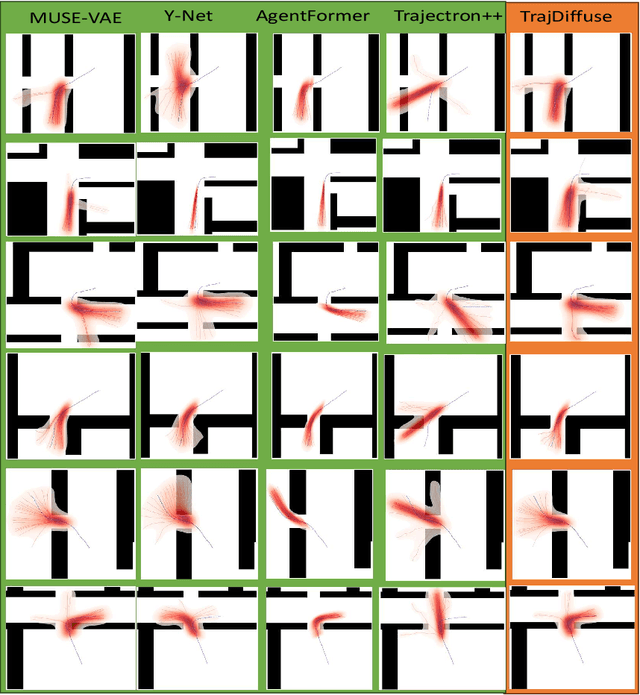
Abstract:Accurate prediction of human or vehicle trajectories with good diversity that captures their stochastic nature is an essential task for many applications. However, many trajectory prediction models produce unreasonable trajectory samples that focus on improving diversity or accuracy while neglecting other key requirements, such as collision avoidance with the surrounding environment. In this work, we propose TrajDiffuse, a planning-based trajectory prediction method using a novel guided conditional diffusion model. We form the trajectory prediction problem as a denoising impaint task and design a map-based guidance term for the diffusion process. TrajDiffuse is able to generate trajectory predictions that match or exceed the accuracy and diversity of the SOTA, while adhering almost perfectly to environmental constraints. We demonstrate the utility of our model through experiments on the nuScenes and PFSD datasets and provide an extensive benchmark analysis against the SOTA methods.
From Words to Worlds: Transforming One-line Prompt into Immersive Multi-modal Digital Stories with Communicative LLM Agent
Jun 15, 2024Abstract:Digital storytelling, essential in entertainment, education, and marketing, faces challenges in production scalability and flexibility. The StoryAgent framework, introduced in this paper, utilizes Large Language Models and generative tools to automate and refine digital storytelling. Employing a top-down story drafting and bottom-up asset generation approach, StoryAgent tackles key issues such as manual intervention, interactive scene orchestration, and narrative consistency. This framework enables efficient production of interactive and consistent narratives across multiple modalities, democratizing content creation and enhancing engagement. Our results demonstrate the framework's capability to produce coherent digital stories without reference videos, marking a significant advancement in automated digital storytelling.
An Intrinsic Vector Heat Network
Jun 14, 2024Abstract:Vector fields are widely used to represent and model flows for many science and engineering applications. This paper introduces a novel neural network architecture for learning tangent vector fields that are intrinsically defined on manifold surfaces embedded in 3D. Previous approaches to learning vector fields on surfaces treat vectors as multi-dimensional scalar fields, using traditional scalar-valued architectures to process channels individually, thus fail to preserve fundamental intrinsic properties of the vector field. The core idea of this work is to introduce a trainable vector heat diffusion module to spatially propagate vector-valued feature data across the surface, which we incorporate into our proposed architecture that consists of vector-valued neurons. Our architecture is invariant to rigid motion of the input, isometric deformation, and choice of local tangent bases, and is robust to discretizations of the surface. We evaluate our Vector Heat Network on triangle meshes, and empirically validate its invariant properties. We also demonstrate the effectiveness of our method on the useful industrial application of quadrilateral mesh generation.
On the Equivalency, Substitutability, and Flexibility of Synthetic Data
Mar 24, 2024Abstract:We study, from an empirical standpoint, the efficacy of synthetic data in real-world scenarios. Leveraging synthetic data for training perception models has become a key strategy embraced by the community due to its efficiency, scalability, perfect annotations, and low costs. Despite proven advantages, few studies put their stress on how to efficiently generate synthetic datasets to solve real-world problems and to what extent synthetic data can reduce the effort for real-world data collection. To answer the questions, we systematically investigate several interesting properties of synthetic data -- the equivalency of synthetic data to real-world data, the substitutability of synthetic data for real data, and the flexibility of synthetic data generators to close up domain gaps. Leveraging the M3Act synthetic data generator, we conduct experiments on DanceTrack and MOT17. Our results suggest that synthetic data not only enhances model performance but also demonstrates substitutability for real data, with 60% to 80% replacement without performance loss. In addition, our study of the impact of synthetic data distributions on downstream performance reveals the importance of flexible data generators in narrowing domain gaps for improved model adaptability.
The Importance of Multimodal Emotion Conditioning and Affect Consistency for Embodied Conversational Agents
Sep 26, 2023



Abstract:Previous studies regarding the perception of emotions for embodied virtual agents have shown the effectiveness of using virtual characters in conveying emotions through interactions with humans. However, creating an autonomous embodied conversational agent with expressive behaviors presents two major challenges. The first challenge is the difficulty of synthesizing the conversational behaviors for each modality that are as expressive as real human behaviors. The second challenge is that the affects are modeled independently, which makes it difficult to generate multimodal responses with consistent emotions across all modalities. In this work, we propose a conceptual framework, ACTOR (Affect-Consistent mulTimodal behaviOR generation), that aims to increase the perception of affects by generating multimodal behaviors conditioned on a consistent driving affect. We have conducted a user study with 199 participants to assess how the average person judges the affects perceived from multimodal behaviors that are consistent and inconsistent with respect to a driving affect. The result shows that among all model conditions, our affect-consistent framework receives the highest Likert scores for the perception of driving affects. Our statistical analysis suggests that making a modality affect-inconsistent significantly decreases the perception of driving affects. We also observe that multimodal behaviors conditioned on consistent affects are more expressive compared to behaviors with inconsistent affects. Therefore, we conclude that multimodal emotion conditioning and affect consistency are vital to enhancing the perception of affects for embodied conversational agents.
 Add to Chrome
Add to Chrome Add to Firefox
Add to Firefox Add to Edge
Add to Edge